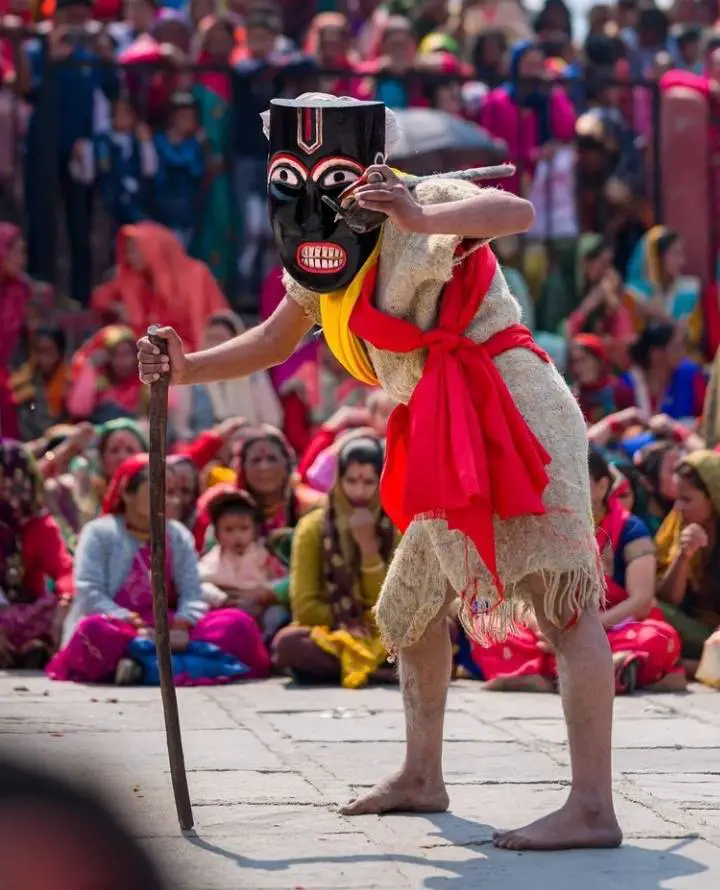Ramman Festival is a unique cultural celebration held annually in the twin villages of Saloor-Dungra in the Chamoli district of Uttarakhand, India. Recognised as a UNESCO Intangible Cultural Heritage in 2009, this festival reflects the living traditions, spirituality, and social structures of the Garhwal Himalayas. It is not merely a religious ritual but a community-driven celebration that binds generations, casts, and professions through storytelling, music, and dance.
Significance of Ramman Festival
The Ramman Festival goes beyond conventional festivities—it plays a vital role in community identity, cultural continuity, and inter-generational learning. Rooted in the epic narrative of the Ramayana, the performances serve as a spiritual homage and a dynamic educational medium. The festival acts as a cultural bridge, connecting younger generations to the values, beliefs, and art forms passed down through centuries.
Besides its religious undertones, Ramman highlights the intricate social fabric of the region. Every caste and occupational group contributes to the festival, showcasing a deep-rooted sense of unity and collective purpose. Tourists visiting during this time not only witness rare traditional performances but also experience grassroots-level cultural preservation in action.
Rituals and Performances of the Ramman Festival
The Ramman Festival typically spans 11 to 13 days and follows a precise ritual calendar determined by the lunar Hindu calendar. Central to the festival are masked dance-dramas, religious recitations, and processions that narrate events from the Ramayana and other Hindu scriptures.
Each community plays a specific role:
- Brahmins perform daily pujas and lead spiritual proceedings.
- Bhandaris, who represent the Kshatriya caste, wear sacred masks and enact important roles such as Lord Ram, Ravan, and Hanuman.
- Youth and elders collaborate in rehearsals and performances, ensuring knowledge transmission.
Major episodes include:
- Ram’s Birth (Janmotsav)
- Sita’s Swayamvar
- Ram’s Exile and Return
- Hanuman’s encounter with Ram
These acts are performed in the temple courtyard and are open to the entire community. The intimacy of the setting enhances the participatory nature of the festival.
The Role of Music in Ramman
Music in the Ramman Festival is both spiritual and dramatic. Traditional instruments like the Dhol and Damaun provide rhythmic support to the performances. Unique musical styles, such as:
- Mor-Morni (peacock dance)
- Khyalari (theatrical ballads)
…are performed with precision and emotional depth. These musical components elevate the storytelling, turning the courtyard into a sacred performance arena.
Cultural Preservation and Community Involvement
The Ramman Festival is a model of community-led heritage preservation. The responsibility for planning and executing the event is shared across households and social strata. There is a strong emphasis on:
- Mentoring younger generations
- Maintaining traditional costumes and instruments
- Documenting rituals for future reference
Local NGOs and cultural organizations have started to support these efforts by recording performances, providing training, and facilitating government grants.
UNESCO Recognition and Its Impact
When UNESCO inscribed Ramman in 2009 as an Intangible Cultural Heritage of Humanity, it validated the village’s efforts in cultural preservation. This recognition brought:
- Increased national and international visibility
- Tourism and economic opportunities
- A boost in local pride
The recognition has also pressured policymakers to support infrastructure and funding for festivals like Ramman, which are otherwise at risk due to urban migration, lack of documentation, and changing youth interests.
Conclusion
The Ramman Festival is not just a celebration—it is a living tradition, a classroom, and a cultural emblem. As India becomes increasingly urban and globalised, festivals like Ramman remind us of the richness and depth of local wisdom and collective creativity.
By promoting, documenting, and participating in such festivals, we not only preserve our past but build a culturally resilient future.




